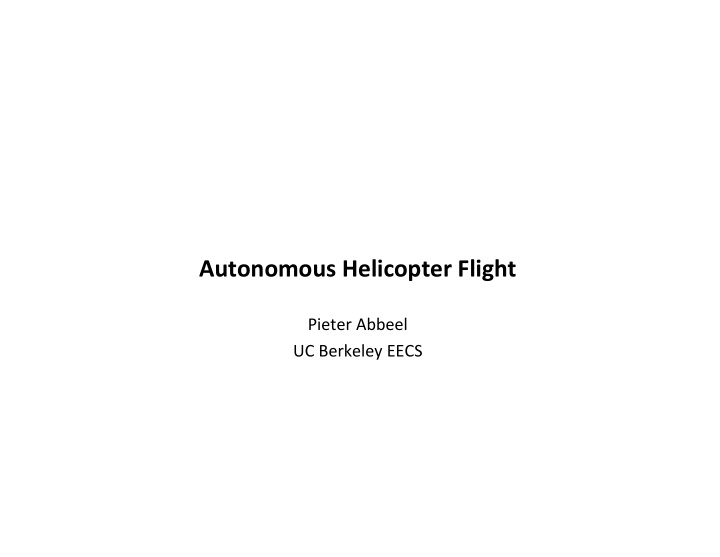



Autonomous Helicopter Flight Pieter Abbeel UC Berkeley EECS
Challenges in Helicopter Control n Unstable n Nonlinear n Complicated dynamics n Air flow n Coupling n Blade dynamics n Noisy es>mates of posi>on, orienta>on, velocity, angular rate (and perhaps blade and engine speed)
Success Stories: Hover and Forward Flight n Just a few examples: n Bagnell & Schneider, 2001; n LaCivita, Papageorgiou, Messner & Kanade, 2002; n Ng, Kim, Jordan & Sastry 2004a (2001); Ng et al., 2004b; n Roberts, Corke & Buskey, 2003; n Saripalli, Montgomery & Sukhatme, 2003; n Shim, Chung, Kim & Sastry, 2003; n Doherty et al., 2004; n Gavrilets, Mar>nos, MeWler and Feron, 2002. n Varying control techniques: inner/outer loop PID with hand or automa>c tuning, H1, LQR, …
[Ng, Coates, Tse, et al, 2004]
Alan Szabo – Sunday at the Lake
One of our first aWempts at autonomous flips [using similar methods to what worked for ihover] Target trajectory: me>culously hand-engineered Model: from (commonly used) frequency sweeps data
Sta>onary vs. Aggressive Flight Hover / sta>onary flight regimes: n n Restrict aWen>on to specific flight regime n Extensive data collec>on = collect control inputs, posi>on, orienta>on, velocity, angular rate n Build model + model-based controller à Successful autonomous flight. Aggressive flight maneuvers --- addi>onal challenges: n n Task descrip7on : What is the target trajectory? n Dynamics model : How to obtain accurate model?
Aggressive, Non-Sta>onary Regimes n Gavrilets, Mar>nos, MeWler and Feron, 2002 n 3 maneuvers: split-S, snap axial roll, stall-turn n Key: Expert engineering of controllers aler human pilot demonstra>ons
Sunday in Open Loop
Aggressive, Non-Sta>onary Regimes n Our work: n Key: Automa>c engineering of controllers aler human pilot demonstra>ons through machine learning n Wide range of aggressive maneuvers n Maneuvers in rapid succession
Learning Dynamic Maneuvers n Learning a target trajectory n Learning a dynamics model n Autonomous flight results
Target Trajectory n Difficult to specify by hand: n Required format: posi>on + orienta>on over >me n Needs to sa>sfy helicopter dynamics n Our solu>on: n Collect demonstra>ons of desired maneuvers n Challenge: extract a clean target trajectory from many subop>mal/ noisy demonstra>ons Abbeel, Coates, Ng, IJRR 2010
Expert Demonstra>ons
Learning a Trajectory Hidden Demo 1 Demo 2 HMM-like genera>ve model • – Dynamics model used as HMM transi>on model – Demos are observa>ons of hidden trajectory Problem: how do we align observa>ons to hidden trajectory? • Abbeel, Coates, Ng, IJRR 2010
Learning a Trajectory Hidden Demo 1 Demo 2 n Dynamic Time Warping (Needleman&Wunsch 1970, Sakoe&Chiba, 1978) n Extended Kalman filter / smoother Abbeel, Coates, Ng, IJRR 2010
Results: Time-Aligned Demonstra>ons § White helicopter is inferred “intended” trajectory.
Results: Loops Even without prior knowledge, the inferred trajectory is much closer to an ideal loop. Abbeel, Coates, Ng, IJRR 2010
Learning Dynamic Maneuvers n Learning a target trajectory n Learning a dynamics model n Autonomous flight results
Standard Modeling Approach 3G error! Abbeel, Coates, Ng, IJRR 2010
Key Observa>on Errors observed in the “baseline” model are clearly consistent aler aligning demonstra>ons. Abbeel, Coates, Ng, IJRR 2010
Key Observa>on n If we fly the same trajectory repeatedly, errors are consistent over >me once we align the data. n There are many unmodeled variables that we can’t expect our model to capture accurately. n Air (!), actuator delays, etc. n If we fly the same trajectory repeatedly, the hidden variables tend to be the same each >me. ~ muscle memory for human pilots Abbeel, Coates, Ng, IJRR 2010
Trajectory-Specific Local Models n Learn locally-weighted model from aligned demonstra>ons n Since data is aligned in >me, we can weight by !me to exploit repeatability of unmodeled variables. n For model at >me t: n Obtain a model for each >me t into the maneuver by running weighted regression for each >me t Abbeel, Coates, Ng, IJRR 2010
Learning Dynamic Maneuvers n Learning a target trajectory n Learning a dynamics model n Autonomous flight results Abbeel, Coates, Ng, IJRR 2010
Experimental Setup Extended Kalman Filter Oxoard Cameras 1280x960@20Hz RHDDP controller “Posi>on” 3-axis magnetometer, accelerometer, gyroscope (“Orienta>on”) Controls @ 20Hz Microstrain 3DM-GX1 @333Hz RPM sensor @20-30Hz Sonar Abbeel, Coates, Quigley, Ng, NIPS 2007
Experimental Procedure 1. Collect sweeps to build a baseline dynamics model 2. Our expert pilot demonstrates the airshow several >mes. 3. Learn a target trajectory. 4. Learn a dynamics model. 5. Find the op>mal control policy for learned target and dynamics model. 6. Autonomously fly the airshow 7. Learn an improved dynamics model. Go back to step 4. à Learn to fly new maneuvers in < 1hour. Abbeel, Coates, Ng, IJRR 2010
Results: Autonomous Airshow
Results: Flight Accuracy
Autonomous Autorota>on Flights Abbeel, Coates, Hunter, Ng, ISER 2008
Chaos [“flip/roll” parameterized by yaw rate]
Thank You
Recommend
More recommend